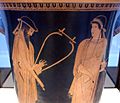Sapphic stanza facts for kids
The Sapphic stanza is a special way to write poetry. It's a group of four lines, also called a strophe. This style comes from ancient Greece and is named after a famous Greek woman poet named Sappho. Many poets in Europe have used this unique way of writing.
How a Sapphic Stanza is Built
A Sapphic stanza always has four lines. The first three lines are quite long, each having eleven syllables. The last line is much shorter, with only five syllables.
In ancient Greek poetry, it was important whether syllables were long or short. But in most other languages today, this rule about long or short syllables is not used. Poets mainly focus on the number of syllables in each line.
History of the Sapphic Stanza
The Sapphic stanza was first created by Sappho in ancient Greece. Later, Roman poets, like Horace, started using it too. Horace was very popular, and his use of the Sapphic stanza helped it spread to many other countries and languages.
This poetic form became very popular in Polish poetry starting in the 16th century. However, it is not used very often in English poetry. One English poet who tried using it was Algernon Charles Swinburne. Here is an example from his poem called "Sapphics":
- All the night sleep came not upon my eyelids,
- Shed not dew, nor shook nor unclosed a feather,
- Yet with lips shut close and with eyes of iron
- Stood and beheld me.
- (Algernon Charles Swinburne, Sapphics)
Images for kids
-
Algernon Charles Swinburne, around the time he published "Sapphics"
See also
 In Spanish: Estrofa sáfica para niños
In Spanish: Estrofa sáfica para niños




